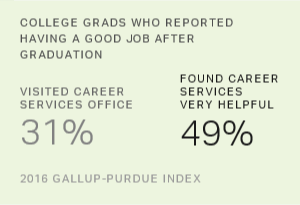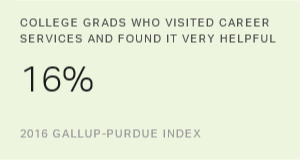Higher education institutions are thinking more about ways to help students leave college with a clearer career path.
Over eight in 10 (83%) college and university chief academic officers and provosts say their institution is focusing more on the ability of its degree programs to help students get good jobs. Public and private college provosts are equally likely to say this. Only 2% of academic leaders in higher education in the U.S. are not increasing efforts to understand how academic programs lead to good jobs.
| All | Public | Private | ||||||||||||||||||||||||||||||||||||||||||||||||||||||||||||||||||||||||||||||||||||||||||||||||||
|---|---|---|---|---|---|---|---|---|---|---|---|---|---|---|---|---|---|---|---|---|---|---|---|---|---|---|---|---|---|---|---|---|---|---|---|---|---|---|---|---|---|---|---|---|---|---|---|---|---|---|---|---|---|---|---|---|---|---|---|---|---|---|---|---|---|---|---|---|---|---|---|---|---|---|---|---|---|---|---|---|---|---|---|---|---|---|---|---|---|---|---|---|---|---|---|---|---|---|---|---|
| % | % | % | ||||||||||||||||||||||||||||||||||||||||||||||||||||||||||||||||||||||||||||||||||||||||||||||||||
| My institution is increasing attention on the ability of our degree programs to help students get a good job. | ||||||||||||||||||||||||||||||||||||||||||||||||||||||||||||||||||||||||||||||||||||||||||||||||||||
| Agree (4s + 5s) | 83 | 84 | 81 | |||||||||||||||||||||||||||||||||||||||||||||||||||||||||||||||||||||||||||||||||||||||||||||||||
| Neutral (3s) | 15 | 13 | 17 | |||||||||||||||||||||||||||||||||||||||||||||||||||||||||||||||||||||||||||||||||||||||||||||||||
| Disagree (1s + 2s) | 2 | 3 | 2 | |||||||||||||||||||||||||||||||||||||||||||||||||||||||||||||||||||||||||||||||||||||||||||||||||
| 2016 Gallup-Inside Higher Ed Survey of Chief Academic Officers | ||||||||||||||||||||||||||||||||||||||||||||||||||||||||||||||||||||||||||||||||||||||||||||||||||||
These findings are from the Inside Higher Ed Survey of College and University Chief Academic Officers, which provides insights into how academic leaders at U.S. higher education institutions perceive and address matters related to academic programming, finances and other issues. Gallup conducted the survey via web from Nov. 2-Dec. 7, 2016, on behalf of Inside Higher Ed.
Not only do many provosts and chief academic officers say they are paying more attention to whether degree programs help students get good jobs, but some institutions are also taking steps to ensure students are just as intentional about their exit strategies from the university as they were in their efforts to get admitted. For example, some campuses are boosting opportunities through their career services offices.
The career services office on campus is typically the hub for connecting graduates with good jobs. Gallup research shows that college graduates who say their experience with the career services office was "very helpful" while they were in school are more likely to strongly agree that their university prepared them well for life outside of college and that their education was worth the cost. They are also more likely to recommend their alma mater to friends, family and colleagues. However, the 2016 Gallup-Purdue Index report found that just 16% of college graduates who visited their school's career services office rated their experience as very helpful.
It is a challenge for budget-conscious higher education institutions to ensure that career services offices have the resources they need to help create a clearer line of sight for students beyond college. But Gallup research suggests the investment may be worth the cost.
In addition to career services, collaborative partnerships on campus, such as project-based learning, mentorships and internships, can help students better prepare for their post-college pursuit of a good job. Provosts and chief academic officers recognize the value of such experiences. The majority (55%) believe internships and work experience are extremely effective enhancements to traditional classroom work, and another 34% say they are very effective.
Such opportunities, in addition to career advising and support and ensuring that degree programs can lead to good jobs, collectively can help students maximize the return on their higher education investment and live their best life after college.
Survey Methods
Gallup conducted the survey via web from Nov. 2-Dec. 7, 2016, on behalf of Inside Higher Ed. The survey is an attempted census of all chief academic officers and provosts in the U.S. using the most comprehensive sample information available. Gallup sent invitations via email to 2,721 chief academic officers and provosts, receiving 654 responses. Respondents represented 332 public institutions, 303 private institutions and 12 institutions from the for-profit sector. Bible colleges and seminaries and institutions with fewer than 500 students enrolled were excluded. Gallup statistically weighted data to correct for nonresponse, matching the obtained sample to targets for all U.S. colleges and universities. The weighted sample results can be considered representative of the views of chief academic officers and provosts at colleges nationwide.
Learn more about how the Inside Higher Ed Survey of College and University Chief Academic Officers survey was conducted.




